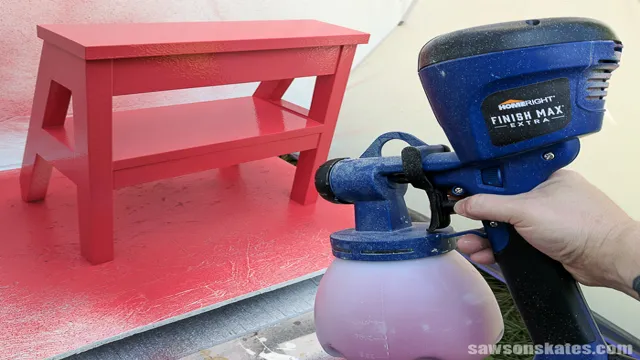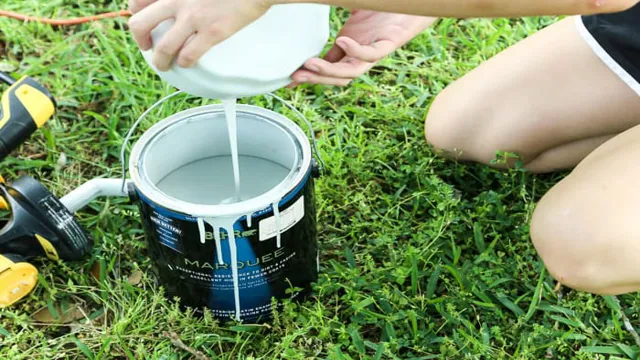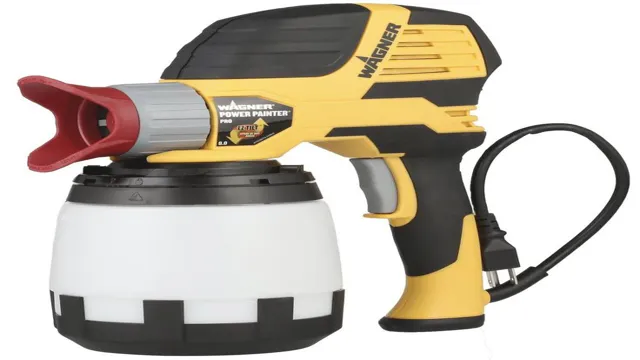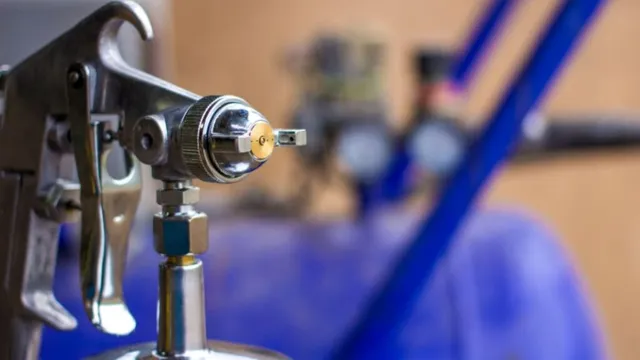Can You Use Any Paint in a Paint Sprayer? Tips and Recommendations.

Have you ever wondered if you can use any paint in a paint sprayer? It’s a common question that many DIYers or painters may have. Painting with a brush or roller can be time-consuming, so using a paint sprayer is a faster and more efficient way to paint. However, using the wrong type of paint can lead to a disaster and cause damage to your paint sprayer.
So, is it safe to use any paint in a paint sprayer? In this blog, we’ll explore the answer to this question and give you some tips on how to choose the right paint for your paint sprayer.
Understanding Paint Sprayers
When it comes to using paint sprayers, not all types of paint are created equal. While some airless and HVLP paint sprayers can accommodate different types of paint, it’s important to use the right type of paint for your specific project and sprayer. Water-based or latex paints work well with many paint sprayers, as they can be easily thinned to the proper consistency.
However, oil-based paints may require special thinning agents to work with certain types of paint sprayers. It’s also important to ensure that the paint you choose is compatible with the material you’re painting, as some paints work better on metal or wood than they do on other surfaces. Ultimately, it’s always best to do some research on the specific paint sprayer you plan to use and the type of paint you will be using to achieve the best results.
So, can you use any paint in a paint sprayer? The short answer is no, but with some research and careful consideration, you can select the right type of paint and get a beautiful finish every time.
Types of Paint Sprayers
Understanding Paint Sprayers Paint sprayers are a convenient and efficient way to apply a coat of paint to walls, ceilings, and furniture. There are three main types of paint sprayers: airless, HVLP (high volume, low pressure), and compressed air. Each type of paint sprayer has its unique features, advantages and disadvantages, and recommended use cases.
Airless paint sprayers use a high-pressure pump to atomize the paint and create a fine spray. This type of sprayer is excellent for large areas and thick coats of paint, such as exterior walls and fences. However, it may cause overspray, and it requires more set-up, cleaning, and maintenance.
HVLP paint sprayers use a turbine to produce a steady flow of air and a lower pressure to atomize the paint. This type of sprayer is ideal for precision work and detail-oriented projects, such as cabinets, trim, and furniture. It provides a smoother and more controlled finish but requires thinner paint and smaller nozzle sizes.
Compressed air paint sprayers use an air compressor to atomize the paint and create a spray pattern. This type of sprayer is versatile and can handle various paint types and viscosities. However, it may produce more noise and require more airflow and pressure adjustments.
When choosing a paint sprayer, consider the size and nature of your project, the type of surface and paint, the level of precision and control required, and your budget and experience. It’s essential to follow the manufacturer’s instructions and safety precautions and wear appropriate protective gear and clothing. With the right paint sprayer and technique, you can achieve a professional-looking paint job with less effort and time.

Advantages of Using a Paint Sprayer
As a homeowner, you might have heard of paint sprayers, but do you know what they are and their advantages? A paint sprayer is a device that can evenly and quickly spray paint onto surfaces such as walls, furniture, and even cars. They are known to make painting faster, easier, and more efficient. The main advantage of using a paint sprayer is that it helps you to save time and effort.
By using a paint sprayer, you can reduce painting time by up to 50% compared to using a roller or brush. Furthermore, paint sprayers can also save you money, as they allow you to use less paint, resulting in less wastage. Another benefit is that paint sprayers can provide a smoother finish, without any brush or roller marks.
This feature is especially important when painting surfaces that require a professional-looking finish. Finally, a paint sprayer can help you achieve an even coating, eliminating drips and preventing any unevenness. In summary, if you want to paint your home or furniture quickly and professionally with minimal mess and effort, using a paint sprayer is definitely worth considering.
Types of Paint
Can you use any paint in a paint sprayer? The answer is not so simple as it depends on the type of paint that you are using. Generally speaking, latex paints and water-based paints work well with paint sprayers, but you may need to thin them out before using them in the sprayer. Oil-based paints, on the other hand, may require a specialized paint sprayer that is designed to handle thicker and more viscous paints or solvents.
Using the wrong type of paint in your paint sprayer may lead to clogging, uneven coverage, and other painting issues. Always consult your paint sprayer manual for specific recommendations on compatible paint types before getting started. Remember, using the right type of paint will not only ensure a smoother and more uniform finish, but it will also help you save time and money in the long run.
Water-Based Paints
Water-Based Paints When it comes to choosing the right type of paint for your next DIY project, there are several factors to consider. One important consideration is the type of paint to use, and water-based paints are a popular choice among homeowners due to their eco-friendliness and easy cleanup. Water-based paints, also known as latex paints, use water as a solvent instead of traditional oil-based solvents.
This makes them easier to clean up with soap and water, and they also release fewer volatile organic compounds (VOCs) into the air during drying. Water-based paints come in a variety of finishes, from flat matte to high gloss, and can be used on a wide range of surfaces, including walls, ceilings, and trim. So if you’re looking for a paint that’s more environmentally friendly and easy to work with, consider giving water-based paints a try.
Oil-Based Paints
Oil-Based Paints Oil-based paints are popular for their durability and versatility. They provide a glossy finish that is long-lasting and resistant to wear and tear. Oil-based paints come in a variety of types, with each having unique characteristics and applications.
For example, alkyd oil-based paints are commonly used for industrial applications, while artists usually use linseed oil-based paints for their vibrancy and smoothness. On the other hand, vegetable oil-based paints are environmentally friendly options that are easy to clean and dry quickly. Out of all the types of paint, oil-based paints can be a bit tricky to work with due to their strong odor and the need for mineral spirits to thin them out and clean up after use.
However, if you’re willing to put in the effort, the result can be beautiful. One advantage of oil-based paints is that they provide better adhesion to surfaces than water-based paints, especially on metal and wood surfaces. They’re also resistant to chipping, cracking, and peeling, making them perfect for painting walls, furniture, and cabinets.
To sum it up, oil-based paints are a great choice for durable, long-lasting finishes. While they might require a bit more work than other types of paint, they’re worth the effort. With their unique properties and versatility, they’re sure to provide you with beautiful and lasting results.
Latex Paints
When it comes to painting your home, you have a lot of options to choose from. One popular type of paint is latex paint. Latex paints, also known as water-based paints, are made up of synthetic polymers that act as binding agents.
There are two main types of latex paints: acrylic latex and vinyl/acrylic latex. Acrylic latex is known for its durability, as it doesn’t crack or peel and has good color retention. Vinyl/acrylic latex, on the other hand, is known for its flexibility and ability to withstand extreme weather conditions.
It’s important to know which type of latex paint is best suited for your project, so be sure to do your research and choose the right paint for the job. One thing to keep in mind is that latex paints aren’t the best choice for surfaces that are regularly exposed to high levels of moisture, as they can absorb water and lead to mold growth. Overall, latex paints are a great option for most painting projects, offering a long-lasting and easy-to-work-with finish.
Choosing the Right Paint for Your Sprayer
Can you use any paint in a paint sprayer? This is a common question that many DIYers have when deciding to invest in a paint sprayer. The short answer is no, you cannot use any paint in a paint sprayer. Different types of paint require different types of sprayers and thinners.
For example, thicker paints like latex require a higher horsepower sprayer while thinner paints like lacquer require a finer sprayer. Additionally, all paints require a compatible thinner to be added to the paint before spraying. It’s important to research and choose the right type of paint and sprayer that are compatible with each other to ensure a successful paint job.
Taking the time to properly match your paint and sprayer will result in a smoother application and a more professional-looking finish.
Viscosity
When it comes to choosing the right paint for your sprayer, one crucial factor to consider is its viscosity. Viscosity is the measure of a liquid’s resistance to flow, and it plays a pivotal role in determining the paint’s sprayability and finish. Most sprayers have specific viscosity requirements, which can affect the quality of the paint application and the sprayer’s performance.
Choosing a paint with the correct viscosity can ensure an even, consistent coat with minimal overspray. High-viscosity paints require a sprayer with a larger tip and nozzle, while low-viscosity paints can be sprayed with a smaller tip and nozzle. It is crucial to follow the manufacturer’s recommendations for the paint viscosity, as deviating from this can result in poor application and unsatisfactory results.
Always consider the viscosity when choosing the right paint for your sprayer, and you’ll achieve excellent results every time.
Compatibility
When it comes to choosing the right paint for your sprayer, compatibility is key. Not all paints are suitable for all sprayers, and using the wrong paint can result in a frustrating and costly experience. Before purchasing paint, make sure you check the paint compatibility with your sprayer.
Most manufacturers’ websites have a compatibility chart or list of suitable paints for their sprayer models. Using a suitable paint will ensure that it sprays evenly and smoothly, reducing the chance of clogging or uneven coverage. It’s important to keep in mind that while some sprayers may work with different types of paints, not all paints are created equal, and some may perform better than others.
So take your time and choose the right paint for your sprayer to achieve a professional-looking finish.
Conclusion
In conclusion, it’s like trying to fit a round peg into a square hole – you can’t use just any paint in a paint sprayer. Each paint type has its own viscosity, drying time, and chemical composition, which makes it imperative to choose the right paint for your sprayer. So, before you go spraying away, do some research and pick the perfect paint for your project – your sprayer and walls will thank you!”
FAQs
What type of paint can I use with a paint sprayer?
While some paint sprayers may have specific guidelines, in general, you can use latex, oil-based, or acrylic paints with a paint sprayer.
Is thinning always necessary when using a paint sprayer?
Thinning the paint is not always necessary, but it is recommended for the best results. Consult the manufacturer’s instructions to determine if thinning is necessary for your specific paint sprayer.
Can you use primer with a paint sprayer?
Yes, you can use primer with a paint sprayer. In fact, using a paint sprayer for your primer can often result in a smoother and more even finish.
Do you need a specific type of paint sprayer for thicker materials like varnish or stain?
Yes, thicker materials may require a specific type of paint sprayer with a larger tip size to accommodate the material.
Are there any safety precautions I should take when using a paint sprayer?
Yes, it is important to wear protective gear such as goggles, a respirator, and gloves when using a paint sprayer to avoid inhaling fumes or getting the materials on your skin.
How do I clean my paint sprayer after using it?
Consult the manufacturer’s instructions for the specific paint sprayer you are using, but generally, you will need to flush the sprayer with water or a cleaning solution and disassemble and clean any removable parts.
Can I use a paint sprayer for touch-up work or small areas?
Yes, many paint sprayers have adjustable spray settings and some even come with smaller attachments specifically designed for touch-up work or smaller areas.



